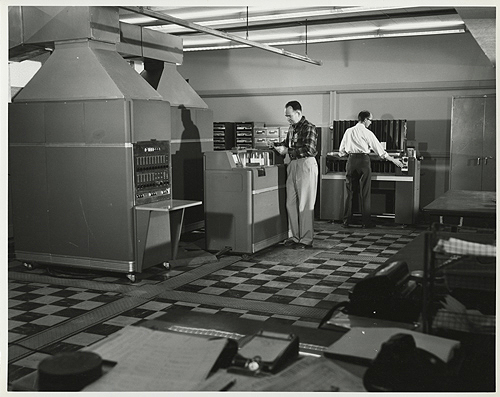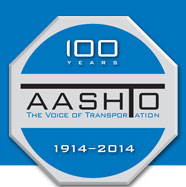
December 17, 2014
Transportation Then & Now: Computer Systems

An IBM 650, dating from 1956, similar to early models used by many highway departments
The following article, published in the April 1964 edition of American Highways magazine, focuses on that era’s slowly but steadily increasing uses of computer technology to support highway engineering and administration needs. In the half-century since N.P. Himbert of Louisiana wrote that article, the electronic applications of what he calls “an inexhaustible tool of expression limited only by man’s imagination and ingenuity” has grown exponentially and become not just extensive in range but far more integral to the daily work and lives of transportation professionals and countless others worldwide.
Electronics in Highway Business Administration
by N.P. Himbert, Department of Highways, Baton Rouge, Louisiana
A few years ago, the first electronic sequence-controlled computer was built and was regarded more as a curiosity than as a practical tool. The far signed administrators of the Highway Industry realized the potential of this new machine and immediately began research programs to determine its economical uses. They learned that the computing system is an inexhaustible tool of expression limited only by man's imagination and ingenuity in programming applications within its vocabulary.
We know that with an adequate computer system and properly trained technicians in its usage that we can achieve many results formerly impractical with the use of conventional methods of machines. Now we can classify information more rapidly and process reports at speeds that were impossible only a few decades ago. We can also perform, with great speed, a wide range of mathematical functions making it possible to speed up the design of our highways, bridges, and facilities.
The use of other electronic machines and devices in conjunction with the electronic computer has further assisted in the updating of Engineering and Business Administration applications, techniques, and controls. Let us consider some of these aids.
1. Mark Sensing and Communications.
In this area cards of varying lengths can be marked-sensed by a device which punches the information into a paper tape. This tape is prepared off line and then placed in a teleprinter for transmission of information to the Computer Center or other desired station. As a by-product a hard copy is prepared at the transmitting station and a tape and hard copy is received at the receiving station. Punched cards can be prepared from the tape or the tape can be used for computer input. This application has been finalized by the Louisiana Department of Highway and will be placed into effect in the first quarter of next year.
This mark-sensing and communication system will enable us to transmit engineering data, payroll time and cost distribution, materials, and supplies used and revived, update and produce from the computer center inventory cards that will be printed at the receiving station, equipment used reports, update personnel information, transmit information and messages from one District office to another as well as to the Central office. This method will eliminate the conventional key punch machine and operation and result in savings as well as paying the entire cost of the communications system.
2. Checking, Storage and Retrieval of Information
Before processing and storage all information should be checked for accuracy. The computer system can be used in many instances for this purpose through the use of control tapes or punched card decks. This is accomplished by comparing the information received with the control tape or punched card deck.
A control tape containing the control sections in the highway system should contain all pertinent information, as to control section number, termini, number of miles, bridges numbers, surface type, location, etc., another control tape should contain function and object codes indicating the object of expenditure applicable to a particular activity and/or control section.
The computer can be programmed to print out information that does not agree and also an exception report indicating the objects of expenditure that have not been reported. After checking and comparisons have been made the information should be stored for future use and Report of Daily Transactions prepared. For accounting purposes general ledger accounts can also be automatically generated making it not necessary to accomplish this purpose manually as presently done.
3. Retrieval and Processing of Reports.
There is much discussion these days with regards to the retrieval of information in every field or endeavor. Retrieval of information is not complicated. Before a program is worked out for the retrieval of information a complete study should be made to determine what information is desired and in what form it is to be presented. A retrieval program can only retrieve the information contained in storage and in the form instructed by the program. If you leave desired information out of the program don't blame the programmer or retrieval method. Your study was incomplete. Effective retrieval programs can be devised to enable management to make its determinations.
4. Reports from Stored Information.
In addition to using the computer for the purpose of designing roads and bridges, research, maintaining budgetary and accounting records required by State and Federal regulations, information stored can be used for management purposes. Only those reports required for accountability of funds should be prepared in detail. Programs should be devised to utilize the great manipulative power of computer to produce reports by exception; that I, presenting only those conditions that require attention, rather than producing such complete records that the significant is buried beneath the unimportant. (In this sense those activities that are running within satisfactory or normal limits are considered unimportant because no corrective action is required.)
In order to realize the optimum from a computer system management must avail itself of the services of a person experienced in business administration, methods and procedures, electronic computer programming, reporting, and above all, imagination and the ability to train and direct a group of technician s to accomplish the desired results. Highway Business Management is in need of the services of such an individual.












